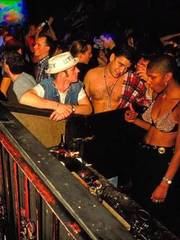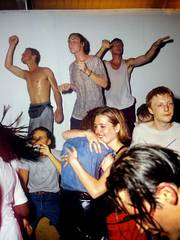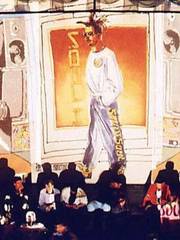"The best days have been and gone", or that's what we always seem to hear, at least. That the London club scene isn't what it once was. Is that actually true? We have some incredible clubs here in London; Fabric, Corsica Studios, Koko, Phonox. But you need a passport to get in, some of the best London clubs we've ever seen have been shut down never to return, or are experiencing a wave of gentrification. We go into the London clubs that paved the way in a time before phones on the dancefloor, dressing to impress, and power-hungry bouncers, that even then were selling overpriced plastic bottles of water and had toilet attendants selling packs of chewing gum and charging for fragrance by the spray. We break it down below...

Plastic People, Shoreditch
Long-known as the host to dubstep's formative FWD parties, Plastic People was a tiny basement club on Curtain Road in Shoreditch, just a couple of doors up from us. It had a world famous sound system and infamously dim lighting, the experience was all about loud music in a dark room. Plastic People achieved iconic status for several reasons. Firstly, its intimate setting created an unparalleled sense of intimacy and connection between the performers and the audience. The club's commitment to pushing musical boundaries by showcasing a diverse range of genres beyond their famous FWD nights, from jazz and soul to experimental electronic music, set it apart from other venues. Big names in music like Theo Parrish, Floating Points and Four Tet held a monthly residency there for over 8 years. Additionally, Plastic People fostered a welcoming and inclusive atmosphere, attracting a diverse crowd of music enthusiasts who valued the club's dedication to artistic expression.
The loss of Plastic People is still increasingly noticeable, despite their doors closing for the last time since 2015, almost a decade ago now. It was a cultural institution that nurtured creativity and community. Its closure left a void in London nightlife scene, depriving today's club-goers of a unique space where they could discover groundbreaking music from legedary DJs and forge meaningful connections with like-minded individuals. Plastic People's absence serves as a reminder of the fleeting nature of iconic cultural spaces in rapidly changing urban environments, leaving behind a legacy that continues to be cherished and looked back upon fondly.

The Blue Note
The Blue Note was opened by Eddie Piller in 1993, after he bought a derelict jazz club called Bass Clef. Straight No Chaser magazine was also ran from there, James Lavelle wrote a column called Mo'Wax for them. Situated at Hoxton Square, the same place we opened our first ever shop (41 Coronet Street forever). Except back then, that part of town wasn't the same Shoreditch as you know it now; it was a lot more dangerous and a lot less cool, theres was only one other club called The London Apprentice, the whole area was pretty much dominated by gangsters. But the club really took off and became a total hub for like-minded music lovers and club goers. Goldie ran a drum n bass night, James Lavelle ran a breakbeat night, Aba Shanti ran a dub night. The club became more popular and so did the area. To the point where to local council didn't want hundreds of people hanging around the square at all hours, so they declared the square a residential area, meaning the club would have to close at 11pm by law. Piller couldn't appeal it, so he shut the club down instead of relocating, leaving it a happy memory for those who know.


Turnmills, Islington
The Victorian building opened in 1886 and was originally used as a warehouse and stables by the Great Northern Railway Company. The building later became a warehouse for Booth's Dry Gin distillery before changing hands in 1985 and becoming Turnmills, until its closure in 2008. Turnmills played a hugely pivotal role in shaping London's club life and gained an iconic status by playing innovative DJ sets and putting on legendary clubnights like Trade, which was a gay clubnight night of emerging electronic dance music. It turned a dingy basement bar into a brightly-coloured safe haven, and was dubbed 'the original all-night bender' that set the standard for gay clubbing. Turnmills was also the first London club to receive a a 24 hour license, which was a total game changer for the nightlife of the city.


The Fridge, Brixton
The Fridge started in 1981, housed inside an old cinema in Brixton, which lent itself to the ambiance of the place. The Fridge was a go-to club during the New Romantics movement back in the '80s, the likes of Grace Jones, Boy George, Pet Shop Boys, Eurythmics were spotted either performing there or attending as a club goer. The club was welcoming to all sorts of from any walk of life, with nights put on for all types of people, giving it a strong sense of diversity and inclusivity. The venue started to gain some traction for its continuous selection of eclectic music nights spanning a tonne of genres. It became more than just a venue, it became a cultural phenomenon, a cornerstone of London nightlife. The Fridge Bar was located next door, where you could go for an after-party on Saturday mornings.






.webp?v=1708603742785&options=w_180)
.webp?v=1708603836081&options=w_180)